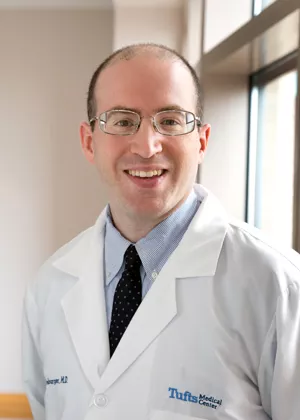
Philippe doesn’t like to sit still. An architect at a firm in Boston’s Seaport, he’s used to being on the move – at work, at home and at the gym. In early 2018, he was forced to slow down when a debilitating back injury interfered with his busy life.
Persistent back pain
“I took a few weeks off and waited for the pain to go away,” he says of the initial, nagging sensation. Resuming his usual exercise routine, Philippe executed a series of deadlifts. The ache returned in his lower back. He took another pause and some ibuprofen. His back seemed to be getting better until squats at the gym aggravated the condition once again.
This time the pain persisted. “By March, I was in constant pain,” says Philippe, 41. A Tufts Medical Center patient for 12 years, Philippe made an appointment with his primary care physician Cinthya Marturano, MD.
First a conservative approach
She referred him to the Spine Center where he learned about non-surgical options to treat his herniated disc. Philippe received cortisone injections as well as physical therapy and chiropractic care.
Unfortunately, the non-surgical treatments were not successful for Philippe. “I was taking 800 mg of ibuprofen as well as extra strength acetaminophen, and it didn’t help much,” says Philippe, who had shooting pains down his leg and into his foot. “I was in a terrible mood and taking it out on my partner. I couldn’t entertain friends or travel — sitting at a table, in a car or on a plane was unbearable."
Throughout Philippe’s treatment, he benefited from Tufts MC’s signature team approach. Dr. Marturano and Spine Center staff collaborated to give Philippe the best, most comprehensive care. Initially, Philippe was helped by the more conservative approach of physical therapy and spinal injections which can prevent many patients from progressing to surgery.
Minimally invasive spine surgery

When Dr. Marturano recommended that Philippe see neurosurgeon Ron Riesenburger, MD, Director of the Spine Center and Co-Chief of the Division of Spine Surgery at Tufts Medical Center, Philippe was ready to consider surgery. According to Dr. Riesenburger, “Philippe’s MRI showed a large herniated disc at the lowest level in the lumbar spine L5-S1. The piece of disc that had come out of place was severely compressing the S1 nerve, resulting in radiculopathy or what is commonly known as “sciatica” type pain.”
Surgery was scheduled for September, three weeks after Philippe’s consultation with Dr. Riesenburger. “I wanted it done as soon as possible at that point,” Philippe says. “I was scared, but Dr. Riesenburger made me feel comfortable. He was honest and direct and described the risks and benefits of surgery.”
Dr. Riesenburger explains that the one-hour, minimally invasive procedure was called a microdiscectomy. “I made a small incision over the L5-S1 level and used an operating microscope that magnifies the operative field and helps me visualize the compressed nerve and disc herniation. After I removed a small amount of the lamina bone, I identified the compressed nerve and the large piece of disc material compressing it. I carefully moved and protected the nerve and removed the herniated disc.”
Recovery + return to work + recreation
Discharged home the same day as surgery, Philippe heeded what the Spine Center called BLT restrictions (bending, lifting, twisting) for the next six weeks. “I was given pain medication but didn’t need to take it,” says Philippe.
Though Philippe was told not to return to work for two weeks, he felt ready in just a few days. He was doing well when he saw Dr. Riesenburger one month after surgery. “I told him he could begin low-impact cardiovascular exercise at six weeks and weight lifting and running at ten,” says Dr. Riesenburger. At twelve weeks, Philippe had no restrictions. He completed physical therapy and made changes at work, opting to use an adjustable standing desk to decrease sitting time.
Tufts Medical Center shines in quality outcomes database
In 2017, Tufts Medical Center became the first hospital in Massachusetts to enroll in the Quality Outcomes Database of the American Association of Neurological Surgeons—a national spine registry tracking patient outcomes following neurosurgery.
Sheila Joyce, a data analyst in Spine Surgery at Tufts Medical Center, collects and analyzes information from patients like Philippe at timeframes before and after surgery. Information from interviews is logged into a database. “When compared to the 100+ hospitals in the registry, Tufts Medical Center ranks highly in improved pain levels, reduced disability and better quality of life,” says Dr. Riesenburger. “This confirms the quality of care we provide our patients.”
Philippe agrees. He says his surgical experience with the Spine Center has been positive. He’s living an active lifestyle once again and is free from back pain. Philippe has one regret about spinal surgery: “I wish I had done it sooner.”